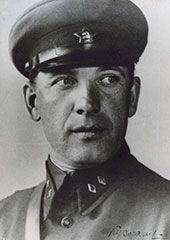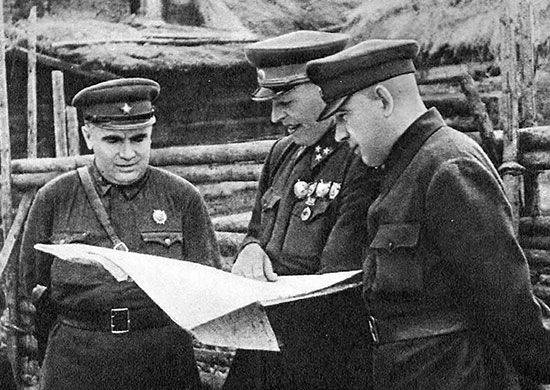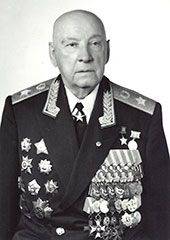Pavel Alekseevich Kurochkin (on the 115 anniversary of the birth)
 Pavel Alekseevich Kurochkin - a prominent military leader, army general (1959), Hero of the Soviet Union. He devoted his whole life to serving the Fatherland. His military talent, organizational skills, decisiveness and courage were especially evident in the Great Patriotic War of the 1941 – 1945 years.
Pavel Alekseevich Kurochkin - a prominent military leader, army general (1959), Hero of the Soviet Union. He devoted his whole life to serving the Fatherland. His military talent, organizational skills, decisiveness and courage were especially evident in the Great Patriotic War of the 1941 – 1945 years.Pavel Alekseevich was born 6 (19) in November 1900 in the village of Gorniewo, now in the Vyazemsky district of the Smolensk region, in a peasant family.
When the boy turned 13 years old, his father identified him as "masterful grub." In St. Petersburg, he worked as a messenger in a pastry shop, and through 3 of the year - in steam repair shops. In the detachment of the Red Guards, railwaymen P.A. Kurochkin participated in the storming of the Winter Palace. It was then that the fate of the peasant lad was determined. To defend the gains of the revolution, in 1918, he joined the ranks of the Red Army.
In the biography of Pavel Alekseevich 3 viewed significant period. These are the Civil War and military intervention, the Soviet-Polish and Finnish wars (1-th period); Great Patriotic War and the postwar period.
During the Civil War, Pyotr Kurochkin participated in battles in repelling the offensive of General P.N. Krasnov near Gatchina, fought with the interventionists in the North, defended Petrograd from the troops of General N.N. Yudenich. In 1920 – 1921 he commanded a platoon, squadron and cavalry regiment. He fought on the Western front with the White Poles, participated in the suppression of the uprising of A.S. Antonov in Tambov. For courage in liquidating the rebellion, he was awarded the Mauser with the dedication of the Revolutionary Military Council of the Republic: “To the stalwart defender of the proletarian revolution.”
Parallel with the fights, Pavel Alekseevich continued his education. I must say that the desire for knowledge of ordinary peasant and working guys was amazing. Having accumulated great combat experience and having gained deep theoretical knowledge in academies, many of them will later become generals, marshals, army and front commanders (AI Antonov and I.Kh. Bagramyan, AM Vasilevsky and NF Vatutin , LA Govorov and MV Zakharov and others - this is a brilliant galaxy of red commanders, students of the Academy of the General Staff, comrades PA Kurochkin). At first, Pavel Alekseevich graduated from the Petrograd cavalry courses (1920), the Higher Cavalry School (1923). From 1924, he is already the head of the regimental school. In 1932, he graduated from the Military Academy named after M.V. Frunze and its adjunct (1934 g.). Since February 1934, P.A. Kurochkin - senior tactical head of the cavalry department at this academy. The young teacher paid special attention to field trips, solving tactical tasks, introducing best practices, infecting the audience with his enthusiasm and enthusiasm.
Having secured military theoretical knowledge, Pavel Alekseevich is again in the army. He is appointed chief of staff, then a brigade commander, and in 1935, the commander of a cavalry division. For the achievement of high results in military and political training is awarded the Order "Badge of Honor." From December 1937 to June 1939. Pavel Alekseevich - head of the training department of cavalry refresher courses for the commanders of the Workers 'and Peasants' Red Army. In the middle of 1939, the Chief of Staff of the Cavalry Corps, since October, the Army Cavalry Group. Participated in the campaign in Western Ukraine.
Looking ahead, let's say that in P.N. 1940 Kurochkin graduated from the Academy of the General Staff (now the Military Academy of the General Staff).
During the Soviet-Finnish War 1939 – 1940. He commanded the 28 rifle corps, which, over the ice of the Gulf of Finland, went into the rear of the enemy's Vyborg group and cut off enemy communications, thereby contributing to the advance of the Red Army on the Karelian Isthmus. From January 1941, P.A. Kurochkin became commander of the Trans-Baikal Military District. And on the eve of World War II (June 19) he was appointed commander of the Oryol Military District.
So, behind Pavel Alekseevich there were three wars. But already the beginning of the Great Patriotic War showed that the German troops, who had lightning speed and subdued almost all of Europe, were perfectly armed and organized, this is a strong and cunning enemy, to fight with which new techniques and methods of military art will be required. How a new combat experience was acquired, especially in the first months of the war, what a high price the fighters and commanders paid while defending every inch of their land — only those who stood in this hell of it knew about it.
On July 5, 1941, Lieutenant General P.A. Kurochkin took command of the 20th Army. The task was difficult: to prevent a breakthrough tank and mechanized divisions of the Nazis in the area between the Western Dvina and the Dnieper. Leading a mobile defense, the 20th Army was able to detain the enemy, who was rushing to Smolensk. In subsequent battles near Senno, Orsha, Smolensk, the 20th Army, with bold counterattacks, inflicted significant damage on the enemy troops, diverting the shock units of the Nazis to itself, which made it possible to create a solid defense in the Smolensk region. The battles went on continuously, around the clock. As a result, the tank and motorized formations of the German Army Group Center had lost up to 23 percent by 50 July, and the infantry ones - up to 20 percent of their strength. And yet the enemy's superiority in men and technology was enormous. On July 22, in the Yartsev area, the Germans managed to close the encirclement ring, in which the troops of the 20th and 16th (Lieutenant General M.F. Lukin) armies found themselves.
The headquarters of the Supreme Command commissioned PA Kurochkina withdraw the troops of these armies from the environment. As a result of the tremendous efforts of the Western Front, and also thanks to the courage and determination of the 20 Army commander, the 20 and 16 Army formations broke through the encirclement, crossed the Dnieper, occupying the defense on the eastern coast and forging a large enemy force there for a long time. For the first time in World War II, German troops were forced to go on the defensive.
Marshal of the Soviet Union S.K. Tymoshenko, the commander in chief of the Western direction, reported in this report: “... Assessing the actions of Kurochkin and Lukin for such a long time against the large forces that violently attacked to encircle and destroy our troops, massaging a large Aviation on the battlefield, Kurochkin and Lukin have to do justice to the heroes. ” On July 27, 1941, the commander of the 20th Army was awarded the Order of the Red Banner for combat skill, courage, and organizational skills. So in the fire of the battle of Smolensk, his talent as a military leader was manifested, his will tempered and his faith in victory grew stronger.
In early August, as a representative of the Stavka, Pavel Alekseevich arrived on the North-Western Front, which suffered heavy losses as a result of a counterstrike under Staraya Russa. For five days he studied the situation, traveled almost all sectors of the front, understood the true state of affairs, and on August 23 1941 was already appointed commander of the troops of this front. Headed by PA Kurochkin North-Western Front held Toropetsko-Kholmsky and Demyansku operations. In 20 January, the Toropets-Kholm operation was fully and successfully completed on the left flank of the front. The cities of Kholm, Toropets, and many settlements were liberated. Soviet troops advanced on the Vitebsk area on 250 km, deeply wedged between Army groups "North" and "Center", making it difficult for their operational interaction. From the west, they bypassed the Rzhev-Vyazma grouping of the enemy, creating favorable conditions for its defeat. The demyan grouping of the enemy (6 divisions) was deeply swept from the north and south. But the elimination of its delayed. And for that there were objective reasons. There were no reserves, the surrounded group was not blocked from the air. Due to the unfavorable terrain conditions (swamps, deep snow, lack of dirt roads), the delivery of ammunition and food, warm clothing to the Red Army was difficult. In addition, the enemy forced to disperse efforts to fight for individual centers, strongly reinforced by him in engineering, gaining time to organize the defense.
Pavel Alekseevich, analyzing the course of hostilities, found the most appropriate way of action. He demanded that commanders of units and formations not to attack strongly fortified settlements from the front, not to surround them, holding down and freezing their large forces, but to bypass them and move forward. It was a true and timely decision. And yet in the middle of March, the Nazis, breaking the encirclement ring, created a ramushevsky corridor, through which replenishment, food, and ammunition were sent to the encircled troops on airplanes (3000 made sorties). In March and May there were unsuccessful attempts to eliminate this corridor. Demyansk operation did not reach its goals, although it held down significant enemy forces.
In the collection "On the North-Western Front" P.A. Kurochkin gave an objective and honest analysis of the fighting of the North-Western Front. "... It should be noted," he wrote, "that the North-Western Front in the first years of the last war did a great deal to reverse the struggle against fascist Germany." “During the defense of Moscow, the North-Western Front, holding down significant forces of the Hitler army, did not allow them to be thrown at the capital. Army Group Center has no divisions in reserve (in the final phase of our battle). ” And a very important conclusion: “The experience we received in the difficult 1942 year, with all its strengths and weaknesses, was invaluable for the future, and in many ways, very much, it made us easier for the victorious 1943 – 1945 campaigns.” It must be said that the Demyansky bridgehead was eliminated in 1943.
How did the further fate of PA. Kurochkina? From November 1942, he led the 11 Army, and from March 1943, the 34 Army, with which he participated in the Starorusskaya operation. From June to November 1943, Mr. P.A. Kurochkin, again the commander of the North-Western Front. 27 August 1943. He was given the rank of colonel-general.

From December 1943, Col. Gen. P.A. Kurochkin was appointed 1 Deputy Commander of the 1 Ukrainian Front. The commander of the front was N. F. Vatutin, with whom he studied at the Academy of the General Staff and together fought on the North-Western Front (he was the chief of staff of the front). At his post, Deputy PA Kurochkin made a great contribution to the preparation and successful conduct of the operation. Here the previous mistakes were taken into account. By the beginning of the operation on the 1-th Ukrainian Front, an almost two-fold superiority in infantry and three-fold in tanks and artillery had been created. In conditions of mudslides, when tanks got stuck on the broken roads, General P.A. Kurochkin organized the work in such a way that all the tasks of the commander were completed on time and in full. With powerful blows from the troops of the 1 of the Ukrainian Front from the west and the 2 of the Ukrainian Front (Army General I. Konev) from the east, the enemy was surrounded by 28 in January of 1944. The operation to encircle and destroy the enemy was carried out brilliantly, it was characterized by a wide maneuver of troops and massive use of tanks and aircraft. Total in the ring were part of the 10 divisions and one brigade. In battles, the enemy lost 55 thousands of soldiers and officers killed and wounded, and more than 18 thousands lost prisoners. For the skillful command of the troops in this operation, Colonel General P.A. Kurochkin was awarded the Order of Kutuzov of the 1 degree.
Since February 1944, P.A. Kurochkin - the commander of the Belarusian Front 2, who participated in the Polesia offensive operation (March 15 - April 5). The start of the operation was unexpected for the enemy and was successful. But since the operation was being prepared as soon as possible, only 13 divisions from 25 were deployed at the beginning. The Germans began to introduce new forces, and the build-up of the forces of the 2 of the Belarusian Front went slowly. What could the front commander do if there was no air support, troops were poorly supplied because of muddy ground roads? The 70 Army, for example, launched an offensive by two out of seven divisions. Therefore, the front only partially completed the task.
From April 1944 until the end of the war, Pavel Alekseevich - commander of the 60 army. In the summer of 1944, the 1 of the Ukrainian Front (Marshal of the Soviet Union I.S. Konev) was preparing for the Lvov-Sandomir offensive operation. 60 Army P.A. Kurochkina was part of the shock group of the front and struck at Lviv. 14 July, 1944 began a powerful artillery and aviation training. As soon as the fire was moved into the depths, the advanced infantry regiments attacked the enemy throughout the entire breakthrough sector. As a result, the Koltovsky corridor was breached. And as soon as the Koltov corridor was formed, PA Kurochkin moved his forward command post there. Subsequently, he recalled: "... When the soldiers and officers see that here, on the front line, the commander, generals and officers of the army headquarters, they have a feeling of even greater responsibility, the morale becomes even higher." The 6-I Guards and 3-I armies were immediately introduced into the 4-kilometer corridor formed. Bursting into the enemy rear, tankers smashed the reserves of the Germans, helping the 60 Army units to successfully complete the combat mission. July 27 in cooperation with other front associations 60-I army liberated Lviv. Her contribution was highly appreciated by the Motherland. Many warriors received high awards, and Kurochkin PA received the Order of Suvorov 1 degree.
Subsequent operations in which the 60 Army participated were no less heroic and successful. After the capture of Krakow (thanks to the skillful actions of our troops, the ancient city of Poland was taken safe and sound), the troops of the 60 Army participated in the liberation of the Slez industrial region. As a result of the rapid onset of mail, all the mines, mines, and factories of the area were returned to the Polish people intact. And on January 27, 1945, the troops of the 60 Army entered Auschwitz, where they released the surviving prisoners of the concentration camp.

Army General Pavel Alekseevich Kurochkin.
Photo 1982
Under the leadership of P.A. Kurochkina 60-I army participated in the Lviv-Sandomierz, Sandomierz-Silesian, Lower - and Upper Silesian, Moravian-Ostrava and Prague operations. Army troops distinguished themselves in the liberation of cities: Ternopil, Lviv, Debica, Krakow, Katowice, Neisse, Biskau (Poland), Moravska-Ostrava (Czech Republic), Prague. For successful military operations, they 14 times noted in the orders of the Supreme Commander. For the skillful leadership of the troops, personal courage and heroism, Pavel Alekseevich in June 1945 was awarded the title Hero of the Soviet Union.
After the war from July 1945, Colonel-General P.A. Kurochkin - Commander of the Kuban Military District.
Since July, 1946 was the deputy commander-in-chief of the Soviet troops and the commander-in-chief of the Soviet military administration in Germany. Since May, 1947. Assistant Commander-in-Chief of the Far East for combat training. From February 1951, Pavel Alekseevich - Deputy Chief of the Higher Military Academy (Military Academy of the General Staff). From May 1954 to 1968, Mr. Kurochkin, PA - Head of the Military Academy named after MV Frunze, Professor (1962 g.). Possessing a rich combat experience, wide erudition, he made a great contribution to improving the academic process of the academy, training highly qualified officers for the Armed Forces of the country. Under his leadership, the research team developed a series of fundamental works on the theory of combined arms combat. In 1968 – 1970 Pavel Alekseevich was the representative of the General Command of the United Armed Forces of the States parties to the Warsaw Pact in the GDR. Since September 1970 he has been in the Group of Inspectors General of the USSR Ministry of Defense. He was a deputy of the Supreme Soviet of the USSR 2-th convocation. He was awarded the Lenin Prize (1980) for his participation in the creation of the Great Patriotic Film Epopee.
Along with the awards mentioned, Pavel Alekseevich Kurochkin was also awarded the Order of Lenin, the Order of the October Revolution, 5 the Order of the Red Banner, the Order of Kutuzov 3, and the Order of the Patriotic War, 1. , medals, as well as foreign orders. Pavel Alekseevich died on December 1 3 in Moscow. He was buried at the Novodevichy cemetery. May the memory of an outstanding, talented military leader, who led our valiant troops to victory throughout the terrible years of World War II, forever lives in our hearts.
Information